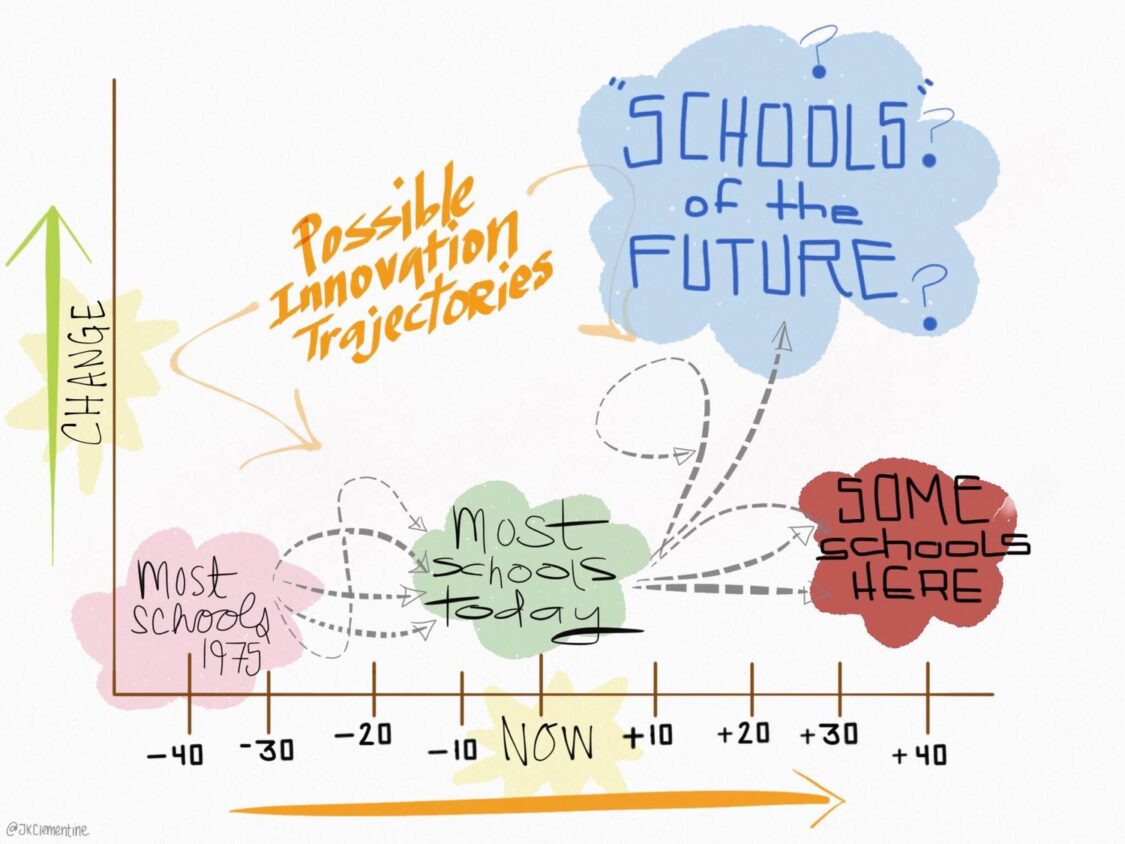When Trajectories of Change Cross

Trajectories are easy to draw, hard to accurately predict, and easy to miss.
Think for a moment about how scientists at NASA might compute the trajectory of a rocket that must land on the asteroid Ceres in ten years. That calculation has to be precise, knowing where Ceres is going to be in the vastness of space in the distant future—and assuming all astronomical conditions are constant. The calculation must also include the exact trajectory of the rocket’s launch and predict the arc of its path toward another moving object.
Rethinking school design in this current Internet Age is arguably akin to rocket science. We hope to prepare students for a fast-paced future where the only certainty is rapid and constant change. There is at least one major difference, though: we don’t know exactly where we’ll land or what we will find when we get there.
For nearly 150 years, schools’ basic operating systems have remained largely unchanged. While students, campuses, technology, and some curricula have evolved, the trajectory of substantive change has remained remarkably flat. Most schools are still preparing students for a future that has largely disappeared in the rearview mirror of the Industrial Age.
Enter the 21st century. Over the last 15 years, a relatively small percentage of school communities have deviated from their past trajectories and embarked on new practices of pedagogy, instruction, and the learning experience. They have begun to reimagine what and how to teach; the relationship between teacher and student; the use of time in the daily and annual schedules; the role of student assessment and measuring what we actually value; the impact of physical space on learning; and more.
This transformation from the Industrial-Age model to a deeper learning model has been uneven, but it is real. Schools that have launched on a steeper trajectory of change find that life becomes messier, more complex, often uncomfortable, but also vastly more exciting, engaging, and relevant for their students, teachers, and extended community stakeholders.
That is great news for K-12 education: we have pilots running in many schools, and those pilots are attracting attention and customers at an ever-increasing rate—and at a steepening trajectory.
The bad news is that some of the targets that even those forward leaning schools are aiming at are fading faster than our investments are offering returns; the trajectory of change has grown so steep that we are struggling to adapt. Many of these targets have been focused on adapting new technologies for use in the classroom: desktops, laptops, pods, pads, smartboards, the Internet, shared documents, digital portfolios, and learning management systems, to name just a few.
Just think about this: in one generation, our elementary-level learning goals at some schools have shifted from typing on a keyboard to using computer-aided design software to program a 3D printing machine to build a prosthetic hand. That is a very steep change curve—and it is the steepness of this curve that demands that we fundamentally change our concept of “school.”
I wrote about school trajectories in this blog post last spring and included this graphic which I think is one you might want to share with your schools:

In his most recent book, Thank You for Being Late, international thought leader and translator of global trends Thomas Friedman summarizes how the decade from 2007-2016 birthed and grew a matrix of major technological innovations that have created what he calls a “supernova” effect of transformation across virtually all aspects of human society.
Friedman cites his conversation with Eric “Astro” Teller, CEO of the Google X research and development lab, who explains that in the past humans have been able to keep up with major advances in technology: the wheel, the printing press, electricity, the telegraph, and the like.
Teller believes we are now at a unique point in human evolution, where the ever-steepening rate of change that is reflected in this graphic has exceeded human ability to adapt. We simply cannot keep up with the constant changes in the world around us—changes in how we live our everyday lives that, in past generations, took centuries or decades to evolve, such as printing, ocean travel, the use of metals, or agrarian practices, now evolve in years or even months: in communication, social interaction, medicine, transportation, and commerce.
“The only adequate response,”says Teller, “is that we try to increase our society’s ability to adapt. We must rewire our societal tools and institutions so that they will enable us to keep pace.”
Teller goes on: “Enhancing humanity’s adaptability is 90 percent about optimizing for learning.” This is an enormous and daunting challenge for educators. The human race’s ability to adapt to a rapidly evolving landscape is almost entirely on us.
This is not an easy pitch to make to any school community. “Great job updating your school to a deeper learning model! But we’re still light years behind.”
Over the last year I have been focusing even more on what is inevitable in the trajectory of K-12 education over the next 20-plus years. The conclusion I am coming to is that almost NO school is on a trajectory that will likely intersect with a set of inevitable conditions influenced by technology, global economics, climate change, etc. Like Teller, I believe that the trajectory of change in the world around us already exceeds our ability to adapt in real time. In future articles and in my new book, Moving the Rock, coming out in September, I will write more about what we can and cannot predict about those inevitable conditions of future schools.
For those of you who are helping to transform schools today, don’t despair. The pedagogy and practices that schools are starting to acquire will not be discarded in whatever form “schools” take 20 years from now. It is the school operating system that will change, adapting more systemically to support the kind of deeper learning that so many of us are helping to nurture. But we also can’t think or assume that what we are helping to create today automatically has much of a shelf life. Constant adaptation to changing conditions requires a flexibility of thinking that has not been a hallmark of schools in the past, but absolutely must be in “schools” of the future.
Rocket scientists know their projections will not be perfect. They might need fuel on board for some course corrections. And they also know that course corrections earlier in the mission are vastly less severe than if they wait too long.
This is the nature of the challenge for schools in a time of almost vertical change trajectory: we can’t afford to wait, or we will miss the future.
By Grant Lichtman – author, speaker, leader, and a member of Transcend’s Yellow Hats League
Transcend supports communities to create and spread extraordinary, equitable learning environments.

